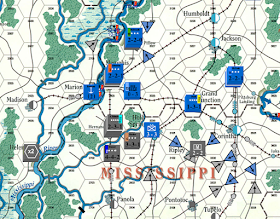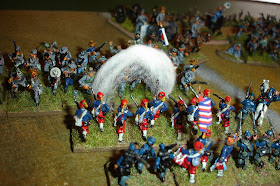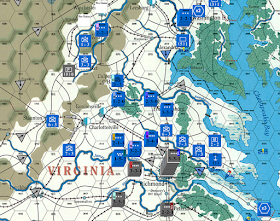The Union have stockpiled 182 supply and get another 180 from production. It's hard times for liberated town supply. There are 10 personnel points from the call for volunteers. A 4-3 division is augmented to a 10-3, a river flotilla is ordered and two siege trains. This leaves 224 supply.
The Confederates carry forward 140 supply, receive 60 from their major cities and 6 from imports. They have 20 personnel points which they convert to be 20 garrison factors (as shortly garrison factors can be directly absorbed into infantry divisions). They have 166 supply left.
The Union receive a Naval Flotilla (East coast) and a River Flotilla (St Louis). A 10-3 division is created in Cairo and a 3-3 division in Bowling Green. The Union carried forward 2,000 militia and have 9,000 returning to the colours from a previous disbandment.
The Confederates receive 10,000 militia and 22,000 garrison troops. The garrisons go to Memphis (10,000), Richmond (10,000) and New Orleans (2,000). A 10-3 division is deployed in each of Memphis, Richmond, Raleigh and Little Rock. This is the result of them implementing the draft back in September 1862 (eh, cycle 9 in game speak).
The Union destroy the fort at Pittsburgh Landing. The Confederates try and build one at Petersburg, spending 40 supply, but failing to complete it.
The Confederates move the Department of South Carolina, Georgia and Alabama from Charleston to Atlanta. They can create more corps, but have no need. Wheeler is promoted to command of the 1st Cavalry Corps.
The Union create the Department of Virginia in Grafton. Sedgewick and Howard appear in Washington, in need of Corps.
Aside: After correspondence with Don Johnston I find I have been too liberal with how I treat abandoned corps. As they are classed as mounted they have some self preservation capability, but their loss is very much meant to represent a military defeat. Without checking back, I think this only occurred with Burnside, Longstreet and Van Dorn' corps. It has been a mistake for me to disband corps (and the Union are now paying the price, although there are still plenty going spare).
Pope is given command of a corps.
12,000 Union militia disband, mainly in Missouri and Pennsylvania.
After some trouble, the Confederates finally launch their last ironclad at New Orleans.
The Union consume 51 supply using 9 rail. This leaves 173 supply and 21 rail.
The Confederates consume 32 supply using 9 rail. This leaves 134 supply and 11 rail. They send 5 supply to Forrest's supply train by water with secret orders, that were published in the Memphis Times, front page, that the supplies are for the garrison of Fort Pillow.
After this round of Kentucky militia in Bowling Green and Missouri militia in St Louis, the Union are only be able to raise them every second month.
There are no partisans.
Week 77
The Union get the 5 chit.
Banks is ordered to force march down the Alabama River and capture Selma. 1,000 men are lost, but it means Banks is going in the right direction, towards the Mississippi.
McClellan goes after Wheeler destroying 1,000 of his tropper and forcing him to retreat. Wheeler is wounded and will be out of action for seven months. Could the war be over before his return?
The new infantry division in Cairo is sent to Union City where McCook is sent to meet it with the railroad repair unit.
Buell is activated. He sends a supply train to McCook along with a small division, 1,000 men "disappear" on the way, and he then moves to confront Forrest at Fort Pillow.
Sedgewick takes himself off to look after Lyon's troops. Burnside sends some isolated brigades to Washington.
Meade and Pope attack. Meade is on the 401-900 column on CRT 3 against Hill. Both sides lose 3,000 men. The forces before Pope, 2,000 cavalry, retreat. Pope crosses over into The Wilderness.
Grant attacks. He is on the 401-900 column of CRT 4. The Union use 1 supply. Jackson's force is eliminated, but the Union suffer equal losses (10,000). Grant is wounded and will be out of action for nine months.
After Grant's hollow victory, Jackson is celebrated as the savior of Memphis and promptly sent to New Orleans. There he finds the newly completed ironclad sitting idle and sends it out to attack the Yankee blockaders. It promptly rams and sinks a USS vessel, but proves to be unseaworthy (failed its SNAFU roll) and goes down with all hands. The Union sailors are left asking "what was that?" and hoping that there are no more.
Beauregard abandons Gordonsville, destroying the railway tracks as he leaves. The cavalry corps is ordered back to Richmond and Stuart is told he better get better real soon.
Taylor takes what cavalry he has and goes to meet the cavalry corps (he's man enough not to be upset by not having been given command of the corps). The garrison of Fredericksburg is left to defend for itself.
Hindman sends reinforcements to Beauregard and Hill. Militia are called up in Drewry's Bluff.
Price sends the new division in Raleigh to Richmond.
Bruckner starts to advance into Tennessee, but realises he won't get far as the damn Yankees have cut the rail line leading from Atlanta. Militia are raised in Cahaba and Montgomery, Alabama.
Forrest pulls out of Fort Pillow, but leaves a 9,000 men to defend it. He retreats across the front of Buell's army, confident that it won't attack.
Can the Confederates establish a secure defensive perimeter around Richmond?
So few men, so much open space.
Seems everyone is heading for Memphis.
Week 78
The Union get the 4 chit.
McCook advances repairing the rail line towards Humboldt, while also sending reinforcements to Buell. Buell detaches McDowell to besiege Fort Pillow. Farragut brings the fleet down to support this operation. Buell and Crittenden then do their best to reorganise the troops after seeing Grant off in an ambulance.
McClernand advances and takes Gordonsville while McClellan comes up in Beauregard's rear.
Sumner moves of his own initiative to St Louis.
No initiative is shown in Alabama or Georgia.
Porter takes the ironclad up the Appomattox and destroys bridges connecting Richmond to Petersburg. No land generals display any initiative in the east. Will there be attacks?
McPherson attacks Hill on the 161-200 column of CRT 3. The Union use supply and both sides lose 4,000 men (which was 20% of the defending Confederates). Hill has a miraculous escape when a sniper's bullet aimed straight at his heart is deflected by the bible he carries in his breast pocket.
Meade fails to attack, but Sedgewick does. He launches an attack on Fredericksburg on the 401-900 column of CRT 3. He uses supply and inflicts 1,000 casualties on the defenders, for an equal loss on his men. Sedgewick takes a bullet, but it was spent and failed to penetrate his heavy winter coat.
Forrest was right, he was perfectly safe to ride in front of Buell's army.
The Union raise militia in Washington and Haggerston (hoping that Burnside will pick up the latter).
Beauregard continues his withdrawal towards Richmond.
Polk is ordered to bring his new division to Memphis. He is not happy as he was planning to use it to liberate Missouri.
Forrest puts what's left of his men into Memphis and then says goodbye, riding out with 3,000 cavalry.
Hindman, sensing Hill is the weak link in Beauregard's escape plan, sends him reinforcements.
Week 79
The Union get the 4 chit again. They are dizzy from all the activity.
McCook is ordered to Jackson in an attempt to secure the Union's rear area.
Buell is told to advance on Memphis. He does so and establishes an extended siege, if only Farragut would sail down and block the water supply lifeline. He does, taking the three ironclads and two of the river flotillas down the Mississippi, isolating Memphis. One river flotilla is lost trying to get past the forts.
McClellan is ordered to keep going, "On to Richmond" being the simple order. He crosses over the James River while McPherson moves up along the north bank. McClernand is then ordered to come in behind McPherson.
Thankfully Meade displays the initiative to close up behind McClernand.
Franklin storms across the Rappahannock and captures Fredericksburg. Sedgwick calls off his attack.
Burnside collects 7,000 militia at Chambersburg.
Halleck with Hooker pull back to Fort Gaines.
McClellan attacks Taylor and both sides lose 1,000 troopers. McClellan has a lucky escape when his tent catches fire as he is writing up his glowing report of his stunning victory.
There are no other attacks.
More militia is raised for Burnside and in Washington.
Buchanan leads his ironclads up the Mississippi. The battle with the Union ironclads is brutal, but, after thinking effective ironclads take no losses and then wondering what happens (as naval combats always result in one side being eliminated, do the Confederates have to retreat?) I checked the rules carefully - I was actually trying to work out how respective fleets could get resupplied - and found that if both sides had effective ironclads then both sides take losses as normal. As a result a lot of iron went down in the Mississippi. Both sides lost two ironclads. Buchanan went down with the pride of the Confederate navy.
Johnston, in charge of the Army of the Mississippi is ordered to save the field army from being trapped in Memphis. It will be a slow extraction.
Beauregard continues his withdrawal towards Richmond. Bragg is ordered to the west of the capital to stop any sudden moves by the Union.
Smith sends the railway repair unit off to get more spares and repairs the blown up bridges. Jackson gets stuck into improving the defences of New Orleans. All the other generals do very little.
Militia is raised in Ripley, MS and in Jacksonville, FL. If the Union retake Jacksonville, that would mean the capture of the State of Florida.
Week 80
The Union get the 5 initiative chit. The end of 1862 has certainly seen the Union very active.
Buell orders Crittenden to besiege Memphis. (Aside: it is possible the Confederates were too hasty in moving their field army from Memphis, but it was likely to get surrounded and so had to get out while it could. If it hadn't moved the previous week it would have got trapped and Memphis subject to an extended siege rather than a close siege.) Reinforcements are sent to McCook and Buell moves down to Grand Junction to block any moves by Forrest.
Banks is ordered to cross to the eastern bank of the Alabama River.
Burnside sends his collected militia to Baltimore and then heads to Front Royal to collect more stranded soldiers.
Pope is given orders to get the railway repaired and head on down to Lynchburg. The Railway Repair unit is sent to him. He is also given Franklin's supply train.
Meade on his own initiative pursues Beauregard. Similarly Sedgewick sends troops to block the roads on the York River. McPherson sends reinforcements to McClellan and pulls in troops from McClernand.
McClellan calls for more reinforcements and passes on the chance to cut the Confederate rail junction at Burkesville.
Meade attacks Beauregard on the 131-160 column of CRT 3. The Confederates use supply, the Union don't. It is a very bloody outcome. 8,000 Union soldiers (15%) became casualties. There are 7,000 Confederates (20%) that won't be going to Richmond for New Year's.
Johnston finds himself unable to move any further as his supply train is stuck in the Mississippi mud. Another good reason to get out when he did, although there is still furious debate around the wisdom of his retreat being conducted amongst the Confederate armchair generals.
Polk is ordered to Helena and to start building a fort. He gets there, but will the necessary supplies for the fort make it? (Aside: Farragut should have sent an ironclad downstream to block Confederate supply, but he is still fishing guys out of the river after the big battle).
Hill takes a corps to Burkesville and was grateful that Smith had repaired the bridges and surprised to find the Yankees hadn't come back to blow them up again (Aside: I am always forgetting to use the US navy to its full capacity).
Beauregard decides to keep on retreating, to the very gates of Richmond itself. The Confederate armchair generals go into an apoplexy over whether this was the right thing to do.
Bruckner recaptures Kingston, GA.
A Hill pulls back towards Atlanta so his supply line won't be a burden on the railways.
Forrest needs to stay put to cover Johnston's retreat from Memphis.
Jackson is asked to explain what happened to the new ironclad that was in New Orleans when he arrived. His five letter response sums it up for the Confederacy: SNAFU.
Memphis under siege
Richmond in peril.
Casualties
Union lost 25,000 as did the Confederates. While this is bad for the Confederates, they are currently recruiting double the number of men through their draft than the Union are managing with their volunteer call.



















































